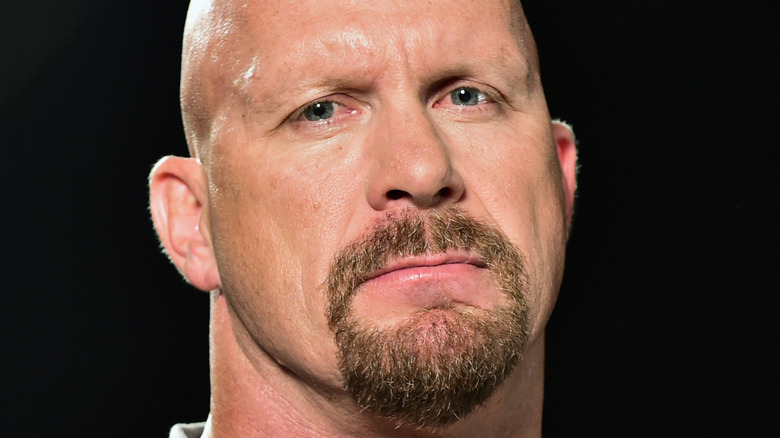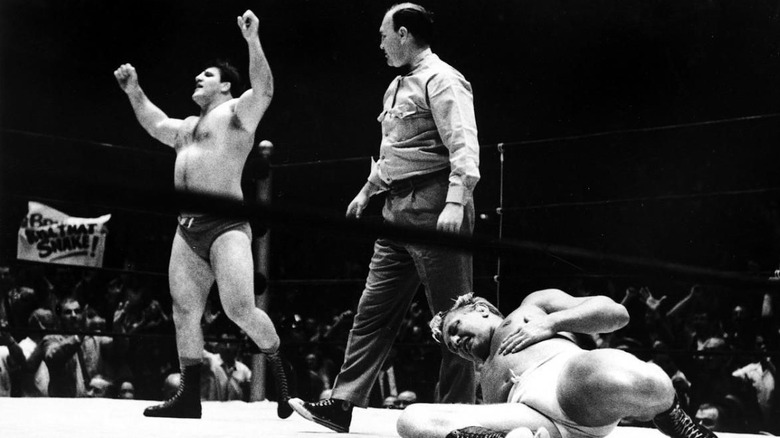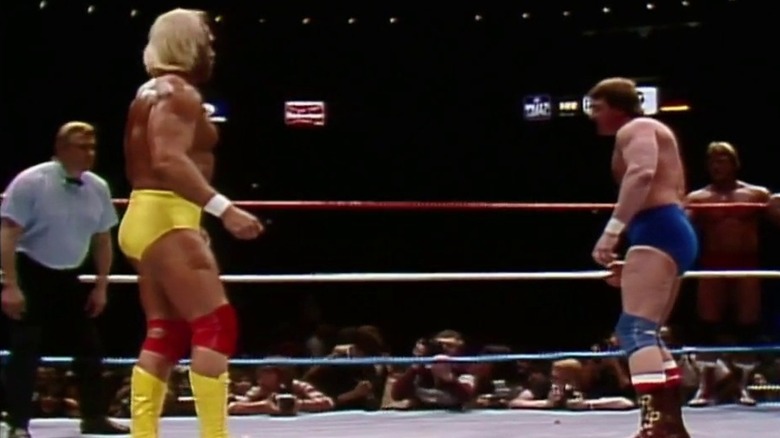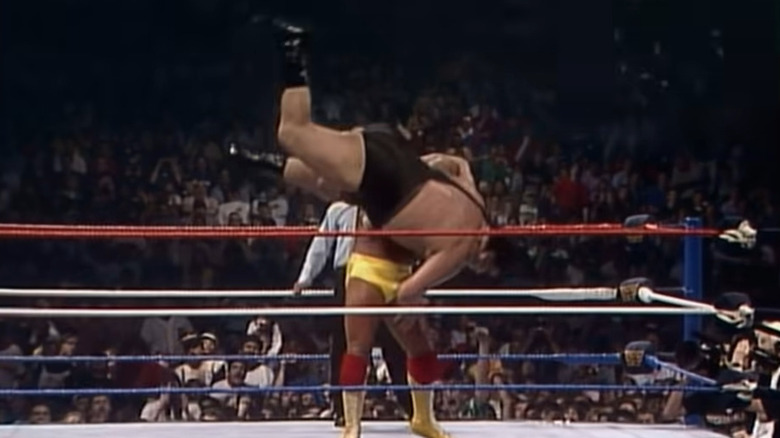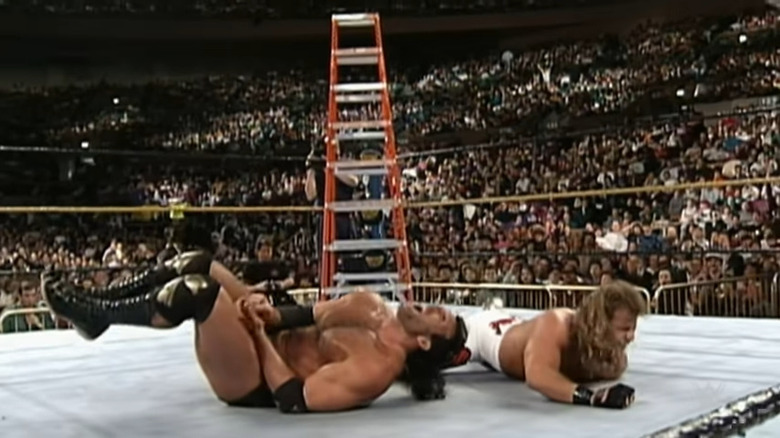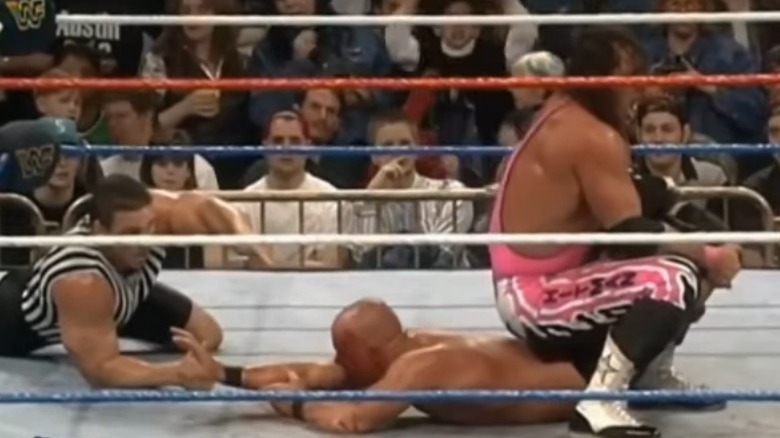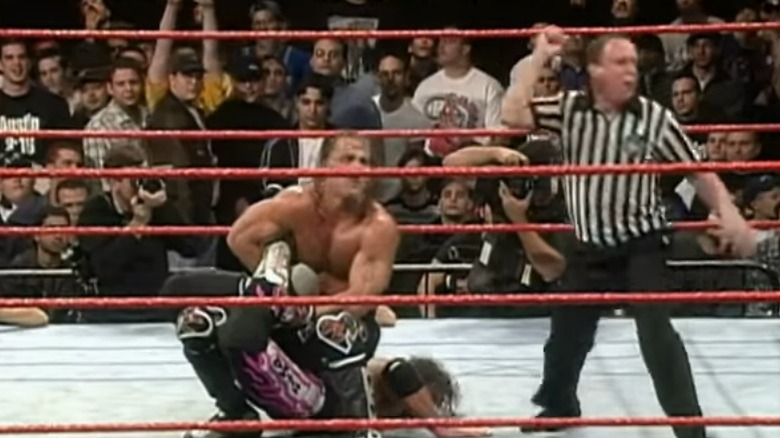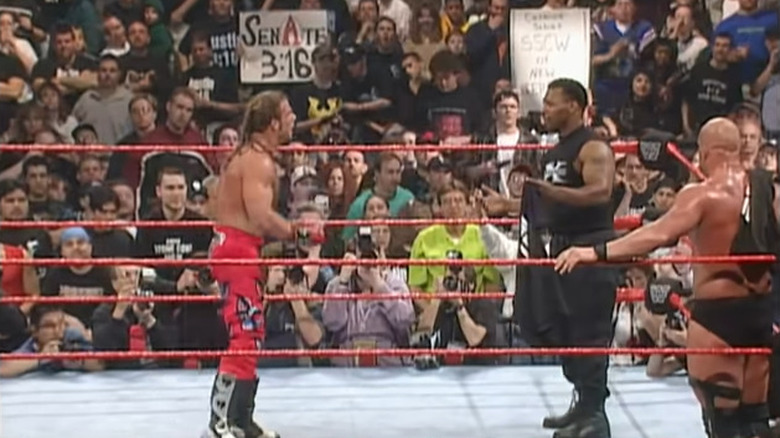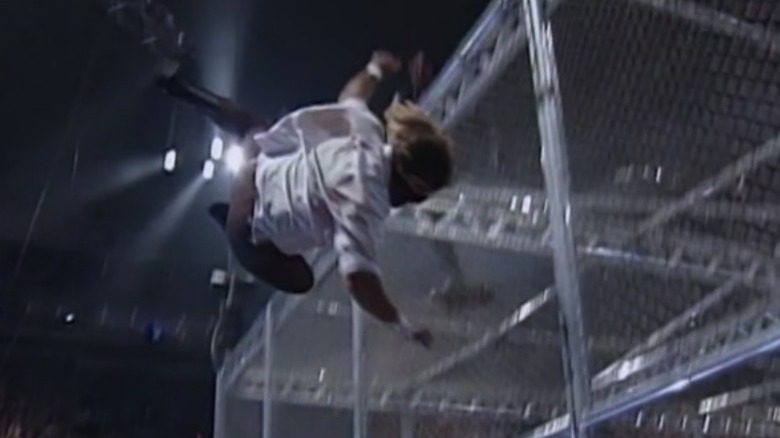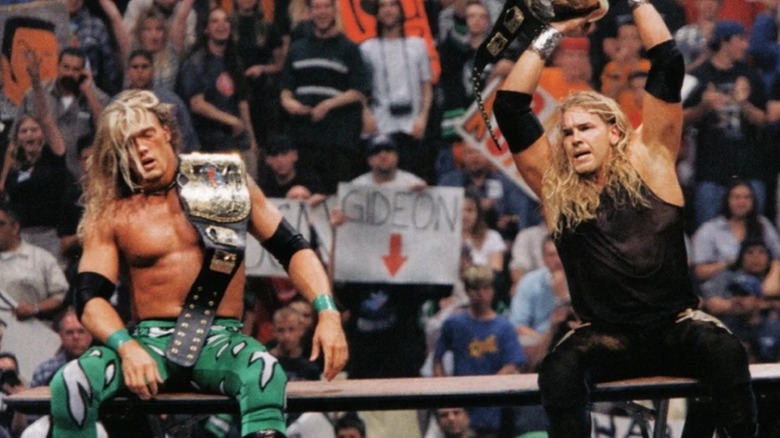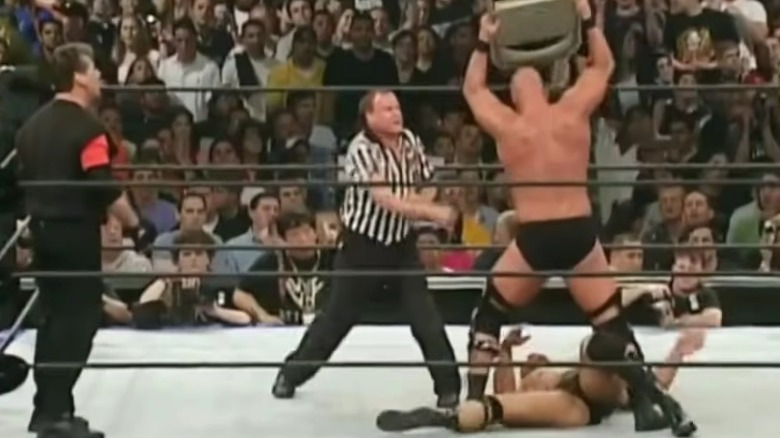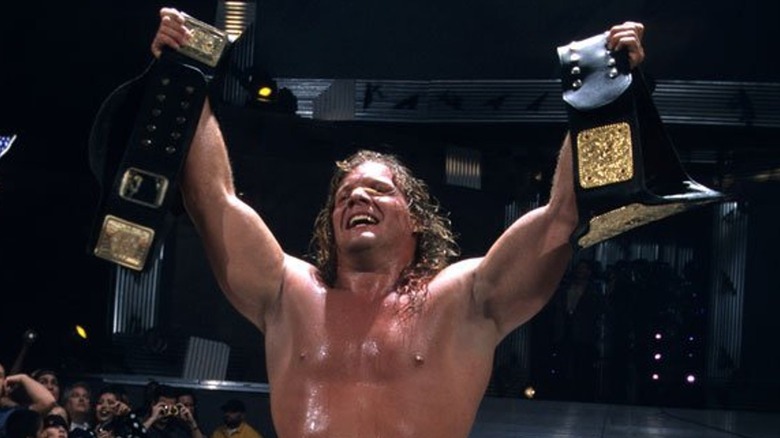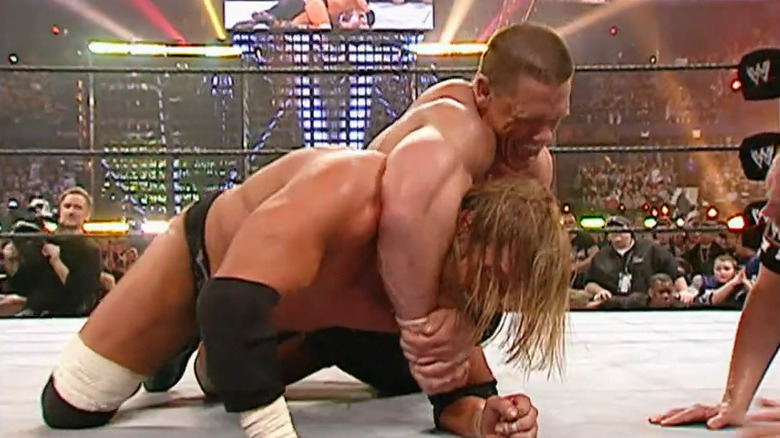The 12 Most Historic Matches In WWE
What are the most historic matches in WWE? If you were to ask Vince McMahon, the answer would be "all of them, pal!" While not every match in McMahon Land can be historic, there have been many matches that have changed the landscape of pro wrestling, er, "sports entertainment." We're going to look at which matches left the biggest mark on the business.
While there are plenty of historic matches, we believe these matches are the most historic because of their long-lasting influence and far-reaching implications for the business. They weren't just memorable; they changed the business. So while "Rock vs. Hogan" makes all the highlight reels, and WWE claims "Roman vs. Brock #756" was "the biggest WrestleMania match ever," neither really changed anything. These matches did. Admittedly, there's definitely a bias for the '80s and '90s because frankly, those were the most popular and historic eras.
Are you ready to mark out ... or elbow-drop your laptop in rage?
Nature Boy Buddy Rogers vs. Bruno Sammartino - May 17, 1963 at Madison Square Garde
WWE history can be divided into BV ("Before Vince") and AH ("Anno Hulkamania"). However, many big things happened during Vincent J. McMahon's ownership of WWE — or rather, the WWWF (or World Wide Wrestling Federation). Choosing just one big moment was a challenge. But when considering what it meant for the then-WWWF, and pro wrestling at large, we went with "Nature Boy" Buddy Rogers vs. Bruno Sammartino for the WWWF Championship on May 17, 1963 at Madison Square Garden.
Proving a match doesn't have to be epic to be historic, Sammartino beat the (supposedly) ailing Rogers in 48-seconds to win his first world championship, becoming the second WWWF Champion ever. The backstory was more interesting than the match, as Rogers claimed he was forced out of his hospital bed following a heart attack, while Sammartino claimed he had to threaten Rogers to do business in the ring, saying: "we can do this the easy way or the hard way."
Whichever version you believe, the outcome began Bruno's nearly eight-year reign that's unlikely to ever be equaled (though Roman Reigns is trying), including selling out MSG an incredible 187 times. Sammartino's 2,803-day reign ended to Ivan Koloff on January 18, 1971, shocking the crowd into stunned silence and causing grown men to weep. It was an historic moment, that capped off one of the most historic title reigns ever.
Hulk Hogan and Mr. T vs. Roddy Piper and Paul Orndorff - WrestleMania
Vince McMahon bought the WWWF from his father on June 6, 1982 for a little more than $640,000. Less than two years later, McMahon put the WWF Championship on former AWA star Hulk Hogan, who defeated the Iron Sheik for the title on January 23, 1984 in Madison Square Garden, kicking off Hulkamania and the "Rock N' Wrestling Connection." Hulkamania ran wild over the next year, as McMahon began his nationwide takeover of the sport, leading to one of pro wrestling's most historic nights: March 31, 1985 ... WrestleMania.
WrestleMania cemented Hogan's status as the face of WWF — and pro wrestling in general — as well as McMahon's vision for a national pro wrestling brand. While WrestleMania wasn't the original pro wrestling "super card" (that was NWA's Starrcade in 1983), it brought pro wrestling to the mainstream, with cameos from such divergent stars as Cyndi Lauper, Muhammad Ali, Liberace, and The Rockettes.
We can debate how important Liberace was to WrestleMania's success, but there's no denying that the main event made the biggest impact. Hogan teamed with one of the era's biggest stars, Mr. T, to take on "Rowdy" Roddy Piper and "Mr. Wonderful" Paul Orndorff. McMahon reportedly could have lost everything had WrestleMania failed. Thanks to this tag team bout on top (a tag match wouldn't close WrestleMania again until 2023), WrestleMania was cemented as "the Super Bowl of pro wrestling" — and WWF as pro wrestling's undisputed leader.
Hulk Hogan vs. Andre the Giant - WrestleMania III
WWF booked three arenas for WrestleMania 2. What could be bigger for Mania III? Selling out one of the largest venues in the world — the Silverdome in Pontiac, Michigan, just outside Detroit. Booking a stadium was a bold move and needed a main event big enough to sell thousands of tickets ("The Killer Bees Explode" wasn't going to cut it). There was only one matchup of this magnitude in the pro wrestling world — WWF Champion Hulk Hogan vs. Andre the Giant.
Hulkamania had been running wild for four years, while Andre maintained his aura of invincibility as a special attraction. Both guys were good guys, so to fix that, Andre broke fans' hearts by tearing the cross from Hogan's neck and aligning with his archenemy, Bobby "The Brain" Heenan. While WrestleMania III's attendance has been long debated (Deadspin even investigated), we can safely say a lot of people showed up on March 29, 1987 to see Hogan do the impossible and slam Andre the Giant. This remains the greatest WrestleMania moment of all time, and capped off one of the biggest events, pro wrestling or otherwise, of all time.
Razor Ramon vs. Shawn Michaels - WrestleMania X
For its 10th edition, WrestleMania came home to the world's most famous arena, Madison Square Garden. Hulk Hogan had gone south to WCW, ending the Hulkamania Era. In its place was a "New Generation" of smaller talent wrestling faster-paced matches, cemented by Bret "The Hitman" Hart winning the WWF title from Yokozuna in the night's main event. While Hart was WrestleMania X's MVP — he also wrestled his brother Owen in a five-star kickoff match — the most historic match was Razor Roman vs. Shawn Michaels vying to become undisputed Intercontinental Champion in a ladder match.
While ladders are about as common as Irish Whips today, that was not the case in 1994. The ladder match debuted in 1972 in Stampede Wrestling (owned by Hart's father, Stu) and was used sparingly afterwards. It came to the WWF in a IC bout between Hart and Michaels in 1992, but WrestleMania X made the ladder match iconic, becoming to modern audiences what the cage match had been before. WWF fans had never seen such high-flying action at WrestleMania, in a match that continues to inspire new wrestlers. This bout established Ramon as the true Intercontinental Champion, Michaels as "Mr. WrestleMania," and the ladder match as the go-to gimmick bout for the next twenty-five years and counting.
Bret Hart vs. Stone Cold Steve Austin - WrestleMania 13
Turning a beloved babyface into a heel is tough. Switching a psychopathic heel into a good guy is even tougher. Doing both in the same match is a borderline miracle. Yet, Bret Hart and "Stone Cold" Steve Austin did just that at WrestleMania 13. As good as it was, it almost didn't happen, as Hart was tentatively scheduled to get his win back from Shawn Michaels from WrestleMania XII. However, Michaels "lost his smile" and couldn't wrestle, so Hart's new arch-nemesis Austin got the shot. That turned out pretty well.
While it was billed as a "Submission" match, this was not a methodically paced Lou Thesz vs. Verne Gange match; it was a fast-paced, cold-blooded, bare-knuckled brawl. It established the Attitude Era-style (chair shots, low blows, lots of blood, fighting around the arena, etc.) that would dominate the WWF for the next five years. The match also produced the most indelible image in WWE history, next to Hogan slamming Andre: a bloodied Austin screaming in pain, yet refusing to submit to Hart's Sharpshooter.
Austin passed out from the pain instead of quitting, becoming a hero in the process. Hart attacked him afterwards, becoming a hated villain. It was pro wrestling perfection. But the match's greatest contribution to pro wrestling history wasn't its quality. Despite WrestleMania 13 setting the lowest WrestleMania buyrate ever at the time, this match made a mega-star out of the biggest draw in WWE history, Steve Austin.
Bret Hart vs. Shawn Michaels - Survivor Series 1997
You know an event is historic when people are still debating and discussing it more than 25 years later. But then again, there's never been a match quite like Bret Hart vs. Shawn Michael for the WWF Championship at Survivor Series 1997 — "the Montreal Screwjob." We won't get into all of the backstory, as literally books have been written, documentaries have been filmed, and millions of words have been typed on forums about this monumental event.
In the most abridged version possible, we'll say Vince McMahon wanted Hart to lose the WWF title to Michaels in Montreal, Quebec, Canada, before leaving for WCW. Bret Hart didn't want to. So during the match, Michaels put Hart in his own Sharpshooter, referee Earl Hebner called for the bell to ring despite Hart not submitting, and Michaels was declared the winner, "screwing" Hart out of the title.
The most immediate significance of this event was establishing Vince McMahon, the company's real-life owner, as "Mr. McMahon" — the evil mastermind who screwed Hart, became "Stone Cold" Steve Austin's arch-enemy, and one of pro wrestling's greatest on-screen villains ever. The long-term significance was creating pro wrestling's most historic controversies of all time.
Shawn Michaels vs. Stone Cold Steve Austin - WrestleMania XIV
WCW creamed WWF in the Monday night ratings war for 83 weeks, which is why former WCW President Eric Bischoff's podcast is called ... wait for it ... 83 weeks. The tide turned on April 13, 1998, when Steve Austin challenged Vince McMahon to a fight. However, the seeds were sewn much earlier.
It started with Austin stunning McMahon for the first time on September 22, 1997, when fans discovered McMahon wasn't just the play-by-play guy but also owned the company. Next came the Montreal Screwjob and "Bret screwed Bret" speech, which established Mr. McMahon as the arch-villain. Finally, Austin interrupting McMahon's welcoming ceremony for "Iron" Mike Tyson on January 19, 1998 in the buildup to WrestleMania XIV. Put simply: no Mike Tyson, not WWF winning the Monday night ratings wars.
While each one of these events was massive, Austin defeating Shawn Michaels for the WWF Championship at WrestleMania XIV on March 29, 1998 effectively launched the Attitude Era's most profitable period, setting the stage for WWE finally overtaking WCW. As Jim Ross proclaimed, "the Austin Era has begun!" While Austin was well on his way to being one of pro wrestling's biggest stars at the time, this match –- and the Austin vs. McMahon feud that followed –- established him as one of the biggest pro wrestling stars of all time.
The Undertaker vs. Mankind - King of the Ring 1998
For better or worse, there are certain moments that pro wrestling fans will never forget. Among Attitude Era fans, the most memorable moment didn't involve "Stone Cold" Steve Austin, The Rock or Mr. McMahon, but Mick Foley and The Undertaker. That moment, of course, was when The Undertaker threw Mick Foley, portraying his character Mankind, off the roof of the "Hell in a Cell" at King of the Ring, on June 28, 1998.
This was truly a before-and-after or "where were you when" moment in pro wrestling. When Mankind went off the cell, all bets were off. Jim Ross screaming "Good God almighty, good God almighty, they've killed him! As God as my witness, he is broken in half!" and pleading for officials to "Stop the damn match!" spoke to this sense of chaos and shock. Yes, some fans had seen bloody death matches from Japan or ECW. But it's one thing to watch a guy get hit with glass on a copied VHS tape or in a 1,000-seat bingo hall; it's another to watch a top star get thrown from 20 feet in the air in front of 17,000 shocked fans.
With its emphasis on unbelievable violence, this match would come to define pro wrestling up to the present day. Every time you see thumbtacks, huge bumps, chair shots to the head, etc., you have this match to thank ... or curse.
The Dudley Boyz vs. The Hardy Boyz vs. Edge & Christian - WrestleMania 2000
Razor Ramon vs. Shawn Michaels from WrestleMania X brought the ladder match mainstream. However, there were only five ladder matches between WrestleMania X in 1994 and WrestleMania 2000 in, well, 2000. There have been literally dozens since the triangle ladder match between The Dudley Boyz, The Hardy Boyz, and Edge & Christian at WrestleMania 2000. There's a reason for that –- the fanbase responded. Big time.
While ladder matches before featured a few high-spots, there was always a focus on selling. Not anymore. This ladder match was wall-to-wall action. As soon as one guy went down, another took his place, turning the ladder match -– and gimmick matches in general -– into glorified stunt shows. However, while some may complain about the state of gimmick matches today, there's no denying this match is a true ballet of carnage. It's what would happen if Michael Bay booked a pro wrestling match, with a barrage of "blink and you'll miss it" mayhem. Love it or hate it, this match (and the TLC bouts that followed) changed pro wrestling.
The Rock vs. Stone Cold Steve Austin - WrestleMania X-7
The Attitude Era was WWE's most popular, so it's only appropriate the match that ended it featured the eras' biggest stars: The Rock and "Stone Cold" Steve Austin. The Monday Night Wars came to a stunning conclusion a few weeks earlier when WWF bought WCW. Little did we know that, in many ways, the WWF we knew and loved would soon end too.
The Rock vs. Austin wrestled for the WWE Championship in the Houston Astrodome at WrestleMania X-7, establishing WrestleMania as a stadium show (notwithstanding a three-year arena run WrestleMania XX and WrestleMania 22). It also established the need for a marquee "dream match" that has defined many WrestleManias since. Yes, Austin and Rock had wrestled many times before, but never at this level of super-stardom. Based on how company teased the face-off for months, this fight felt like the first time. Truly, this was a case where neither man could afford to lose ... yet one had to.
While The Rock lost, it was only after Austin aligned with his arch-nemesis, Mr. McMahon, a stunning end to one of pro wrestling's greatest feuds. It also likely lost some fans forever. The match was a masterpiece, the event was a blockbuster, and while WWE is still huge, Austin turning heel ended the Attitude Era. 20 years later, WWE has never reached the same highs since.
Stone Cold Steve Austin vs. Chris Jericho - Vengeance 2001
Who would be the first guy to hold the WWE and WCW World Championships at the same time? Hulk Hogan? "Stone Cold" Steve Austin? Ric Flair? The Rock? Sting? Goldberg? Triple H? Turns out, none of the above. The first Undisputed Champion was a guy who had been curtain-jerking against Juventud Guerrera just four years earlier: Chris Jericho. WWE had purchased WCW in March of 2001, ran a poorly received Invasion angle through the summer and fall, and finally united the WWE and WCW (now World) titles into one Undisputed Championship at Vengeance.
The setup was a mini-tournament, Jericho vs. The Rock for the World title and Austin vs. Kurt Angle for the WWE title, with the winners facing each other. It's almost poetic that the fate of WCW's title would be decided between four WWE guys in a C-level PPV (with fans already ticked because Triple H wasn't showing up). In the end, Jericho won after much chicanery, not only becoming the first Undisputed Champion, but beating The Rock and Austin on the same night. While WWE has had two World titles for most of the past 20 years, there's no denying that on this night, something we never thought would happen did, with the most unexpected outcome there was.
John Cena vs. Triple H - WrestleMania 22
John Cena defeated John Bradshaw Layfield for the WWE Championship in the sub-main event at WrestleMania 21, but the night's real main event was Batista beating Triple H for the World Championship. WWE soon realized that while Batista was a big star, Cena was "The Guy" — someone they could build the brand around and finally replace the star power void left by The Rock and Austin's departure. Cena moved from "SmackDown" to the flagship show, "Raw," and worked his way through top guys like Chris Jericho and Kurt Angle.
However, adult male fans turned on his goody two-shoes act, with dueling "Let's go Cena"/"Cena sucks" chants becoming common. So much so that, when John Cena took on Triple H at WrestleMania 22, many expected WWE would abandon the Cena babyface experiment and put the belt back on Vince's safety blanket. Instead, Cena made The Game tap out in front of 17,000 shocked fans.
This match not only cemented Cena as WWE's top star, by far, but would define WWE's antagonistic relationship with the fanbase for the next 15 years. Whether it was John Cena or Roman Reigns, fans could boo the babyface all they wanted; McMahon would continue digging in his heels about not turning his babyface heel.
